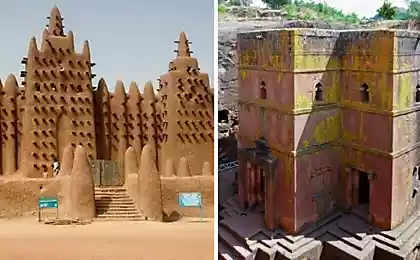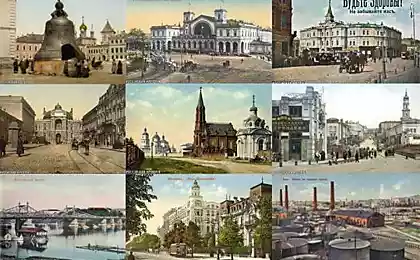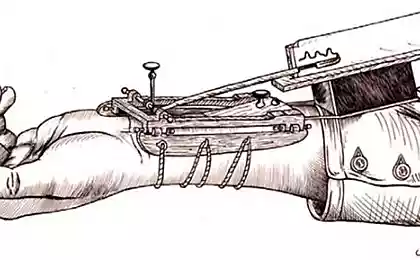1581
Palmyra
Photo tour of the ancient city - Palmira
Palmyra - one of the richest cities of late antiquity, situated in one of the oases of the Syrian desert between Damascus and the Euphrates, 240 km north-east of the first, and 140 km from the second.

On the golden, sun-warmed walls carved leaves and bunches of grapes, camels, eagles. Before our time has remained unreconstructed Palmyra, later layers it does not obscure.
In the history, there are many amazing paradox: Pompeii, for example, has kept us volcanic lava and Palmyra - human forgetfulness. She was thrown and forgotten people.
And once it started with Efki - underground source with lukewarm water, donating sulfur. Desperate travelers, pilgrims, merchants staged a halt here, watered tired camels, horses and donkeys, smashed the tents for the night. Over time, there grew up a kind of transshipment point - the intersection brisk sale. Then he turned to the city's customs, inns and taverns. City changers, traders, hawkers, Konovalov, vagabonds, soldiers, priests, many different religions, doctors, runaway slaves, masters of all trades.
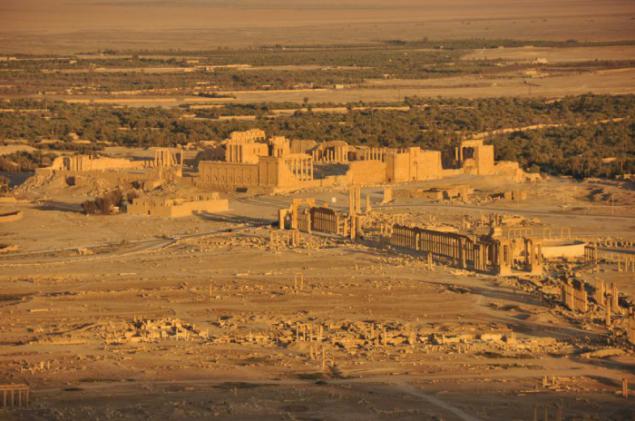
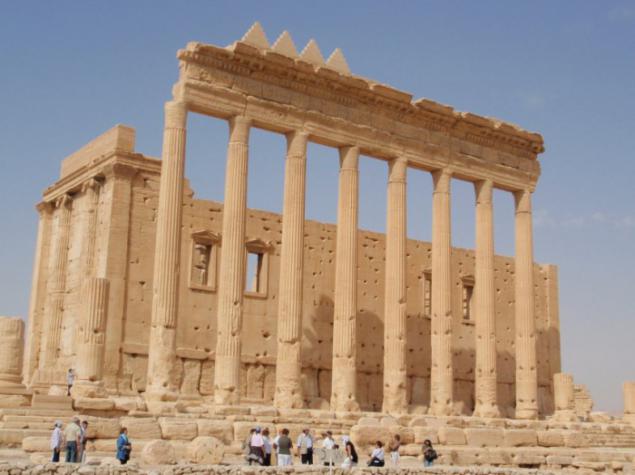
And once it started with Efki - underground source with lukewarm water, donating sulfur. Desperate travelers, pilgrims, merchants staged a halt here, watered tired camels, horses and donkeys, smashed the tents for the night. Over time, there grew up a kind of transshipment point - the intersection brisk sale. Then he turned to the city's customs, inns and taverns. City changers, traders, hawkers, Konovalov, vagabonds, soldiers, priests, many different religions, doctors, runaway slaves, masters of all trades.
It sold male and female slaves from Egypt and Asia Minor. Highly prized wool, dyed purple; merchants, touting their wares, argued that compared with other Palmyra purple fabric faded look, as if they cast dust. From Arabia and India brought spices and aromatic substances. Always has been the demand for wine, salt, clothes, harness and footwear.

Under the arches of the Arc de Triomphe were traded stood multilingual hum, but it was called Arc Europeans. In their submissions arches and gates are set to praise the high-profile military victories and in honor of the great generals. But Palmyra architects to solve other problems: double gates arches were set at an angle and how to conceal fracture streets, straightened her.
To have survived the second important crossroads of the city - tetrapylon. It was built from granite monoliths on four huge pedestals. Here, too, was in full swing trade, stone floors shops have survived to the present time.
The city had many temples built their fun on the conscience.
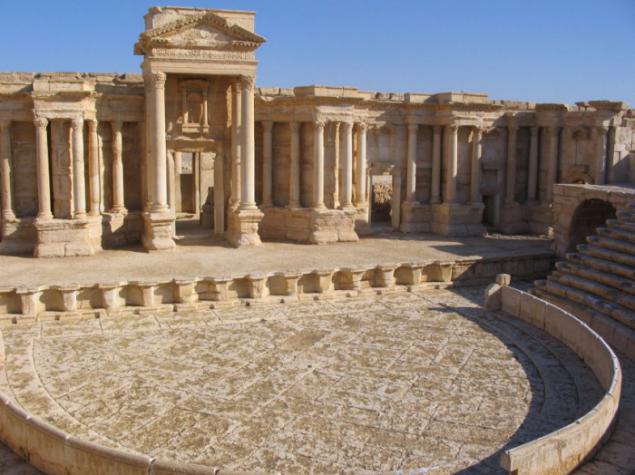
Palmyra were multilingual people, wanderers of the desert, they did not want to obey God only. In their religious rituals they are often remembered Bel - god of the sky, it is dedicated to one of the most interesting churches in the Middle East (the prototype of Baalbek). Temple stood out among all the buildings in the city, had a central hall area of 200 square meters. It was then, and spread throughout the ancient East the fame of the beauty and perfection of Palmyra.

In the temple were three entrances decorated with gilded panels. Today they are replaced plank gate through which tourists get to the sanctuary. Broken plate crowned dragon's teeth, giving sanctuary menacing look. It preserves the special entry that was made for the slaughter of camels, bulls and goats, as well as drain the blood - the god Bel demanded victims.
In Palmyra temple was built in honor of the god Nabq - son of Marduk, the Babylonian ruler of heaven. TOY was in charge of the fate of death, and was a messenger from the gods mingled Palmyra pantheon. A native of Mesopotamia, he got on with Baalshaminom Phoenician, Arab and Allat Olympian Zeus.
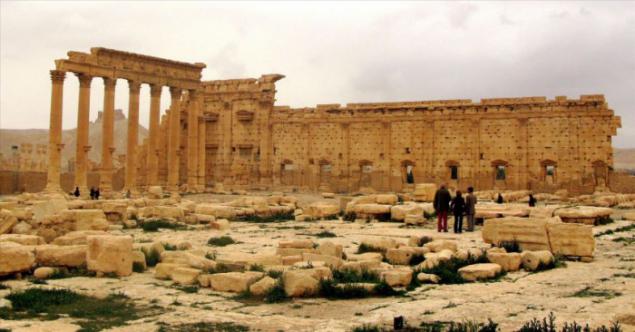
From the temple of Nabq was alone the foundation of the temple Allat - only the door, but the temple Baalshamina (Phoenician god of thunder and fertility) stands to this day.
And earthly affairs were in charge of Palmyra leaders, priests, rich merchants, who sat in the Senate. Their decisions are approved by the governor appointed by Rome. The Emperor Hadrian visited Palmyra, gave the city a certain independence - recalled the governor, cut taxes, the government gave local chiefs.
There were years, flew decade, Palmyra and gradually became one of the most prosperous cities in the Middle East. Just as in Rome, where gladiatorial contests were held, young men fought with wild beasts. Frantihi of the upper classes to dress according to the Roman fashion, and even ahead of it.
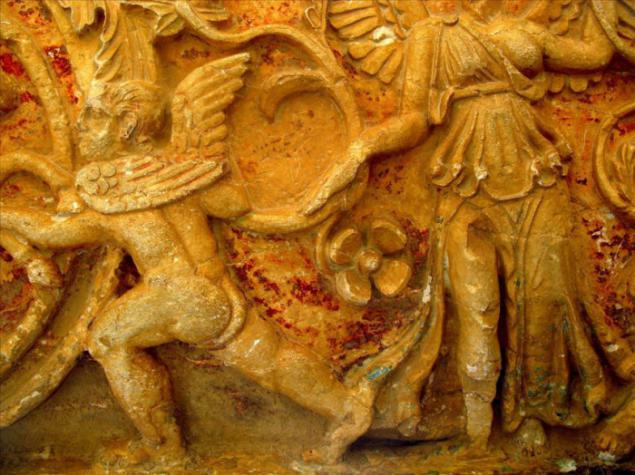
Children were given Roman names, often in conjunction with Palmyra.
Ancient palmirtsy loved erect monuments to each other. Almost all of the Big column colonnade, temples and public buildings are in the middle of the stone ledge on which stood statues of notable and respected people. At one time, the column of agar (Palmyra forum, surrounded by porticos and laden with busts) were kept about 200 of such images.
But gradually stopped listening to the leaders of Palmyra Senate began its policy. The ruler of Palmyra Odenat defeated the troops of the Persian king, but he was well aware that any attempt to elevate his cause in Rome, fear and anger. But regardless of his will and Palmyra, and he gained more and more influence in the Middle East.

Then resorted Rome (as it is very often the case) to a simple means - the physical elimination of man. Roman authorities Suri in year 267 (or 266) Odenata invited to discuss current affairs in Emessu (modern city of Homs). And there, during a meeting he and the eldest son of Herodians fell into the hand of his nephew Meon.
According to other historical records, the murder of Odenata involved his wife, Zenobia, who was stepmother Herodians. She allegedly wanted to eliminate both of them to make way for the authorities to his young son Vaballatu. In fact, the energetic widow of the rules themselves. With its name is associated with great fame of Palmyra, expanding the boundaries of the state. She endured the hardships of military campaigns as well as any of his soldiers.
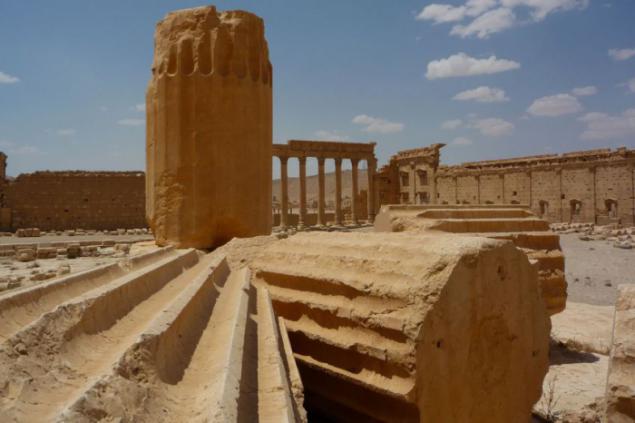
In the local language the name of Zenobia sounded like Bat Zobbi. Translated into Russian, it means - the daughter of a merchant, the merchant. She was a very beautiful woman, it can be seen even on the coins, which have preserved its image. "Matt, dark skin and black eyes of striking beauty, look alive with the divine splendor. She dressed in luxurious costumes, the military was able to wear armor and weapons ».
According to ancient chroniclers, Zenobia was an educated woman, esteemed scientists, sympathetic consideration to the philosophers and sages.
The Roman emperor Gallienus had hoped that the second son Odenata under age will not be able to manage Palmyra. However, he did not realize that the widow, the beautiful Zenobia, the cleverest and the education of women, was ready to engage in public activities. Her teacher, the famous Syrian philosopher Cassius Longinus from Emessy, advised her to enthrone Vaballata with him and become regent. She cautiously waited an hour expulsion of the Roman legions from the Middle East to adopt forever in the kingdom, which it will, the power of his dynasty.
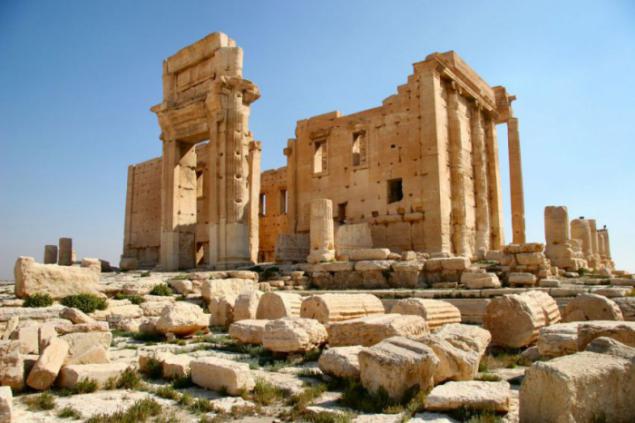
For the time Zenobia carefully hid their intentions, hoping that will help her son to inherit his father's throne. But Rome was afraid enhance margins and retained only the title of the ruler of Palmyra vassal potentates. And then Zenobia declared war on powerful Rome.
The Romans believed that the troops Palmyra refuse to go into battle under the command of a woman. And much miscalculated. Palmyra chiefs Zabbey Zabda and swore allegiance to Zenobia. Jumping to her side the army soon took possession of Syria, Palestine, Egypt, and the north reached the Bosporus and Dardanelles straits.

Military victory Zenobia alarmed Rome. Roman Emperor Lucius Domitius Aurelian decided to oppose her army. After the defeat at Homs Zenobia in Palmyra had hoped to sit, but to sustain a long siege failed. It only remained to take all the wealth of the city and retreat to the Euphrates - and then save the width of the river and accuracy of archers famed Palmyra. But the cavalry Aurelian followed on the heels, and the river itself Zenobia captured. Palmyra fell.
It was seventeen centuries ago. The further fate of Zenobia mysterious and generates a lot of conjecture: if headstrong queen was murdered, though her in golden chains held in Rome, though married to a Roman senator, and she lived to old age.
Taking Palmyra, Roman armies brought down the statue of Zenobia, but the town was not touched. When the Emperor Diocletian is even resumed construction: Zenobia residence was converted into a Roman military camp, the barracks are expanded, improved water, erected Christian basilica.

Several times palmirtsy uprisings for independence, but failed.
Gradually he left the city to know the city, deprived of connections with the East went merchants, followed by the idle drivers were caravans, officials and skilled craftsmen. And Palmyra beginning to wither, become commonplace in the border post, a place of reference.

The Arabs have taken it without a fight, the citizens could not even put up resistance. Yes, they have not lived in the city, and huddled behind the walls of the sanctuary of Bela, nalepili there are many dark and cramped mud shacks. After 2-3 generations no one and did not remember the names of the gods, nor the names of temples or public buildings destination.
Then for many years to come the Turks who do not have a clue about the culture of the peoples subject to them, and others are not allowed to study it. Excavations have been banned throughout the Ottoman Empire. Nobody cared about the past, to the glorious history of the city is now dying. Oblivion Dust hid Palmyra from the living memory of mankind. Palmyra had to be rediscovered.
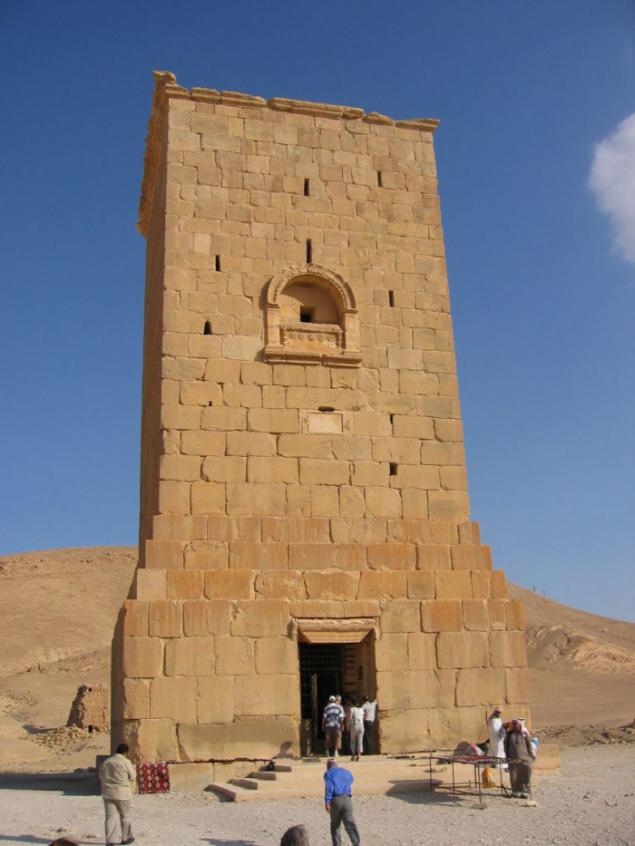
The honor of opening Palmyra history attributes the Italian Pietro della Valle. For a long time, with great difficulty getting to Palmyra travelers in the XVII century, but when they returned to Europe, they just do not believe it. City in the Syrian desert? Would this be? But after 100 years, the artist brought to England Wood drawings made in Palmyra. With the publication of these engravings and started the fashion for Palmyra, were detailed descriptions of the ancient city, travel essays.

The most interesting finding of the time made our compatriot, Petersburger SS Abamelek Lazare. He discovered and published the Greek-Aramaic inscription detailing the customs rules (so-called "Palmyra tariff"). Today this document is stored in the Hermitage. In ancient times, the locals called (it is now called) Palmyra "Tadmor." Translated it means "to be a wonderful, beautiful».

In the XX century it seriously interested. Gradually but steadily growing interest in Russian to Palmyra. Russian Archaeological Institute in Constantinople, sent an expedition, the researchers did a lot of photos, drawings, diagrams, plans, topographic maps of the city. On the basis of these materials Professor F. Assumption issued after a thorough work.
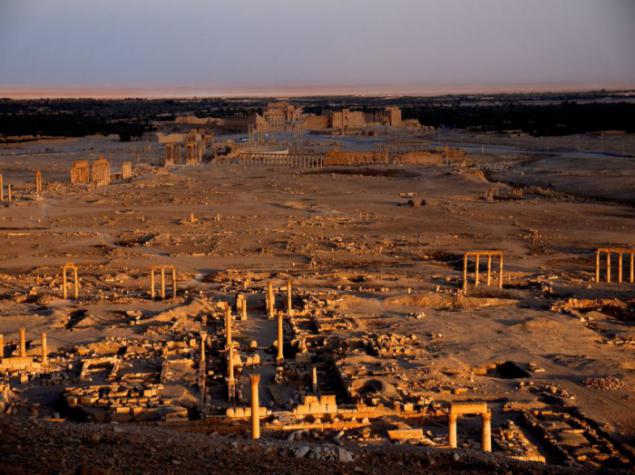
Towering in the desert colonnades legendary Palmyra still beckon travelers who are surprised to discover two neighboring Palmyra - Tadmor two. One of them - the old, the other - the new, young. In one of them it is no longer people live, it has become a perpetual museum, the other from 1928 began to settle Bedouins, poor people. In 2003, the Syrian government passed a law on the construction of a new Palmyra. The city has become improving, new streets were built, electricity. Hardworking inhabitants are laid palm groves, orchards, vegetable gardens, plowed fields, bred cattle. Traditionally palmirtsy engaged in trade, weave carpets, shawls, sew national clothes and sell all tourists. New Palmyra does not compete with the old, because she is its continuation.
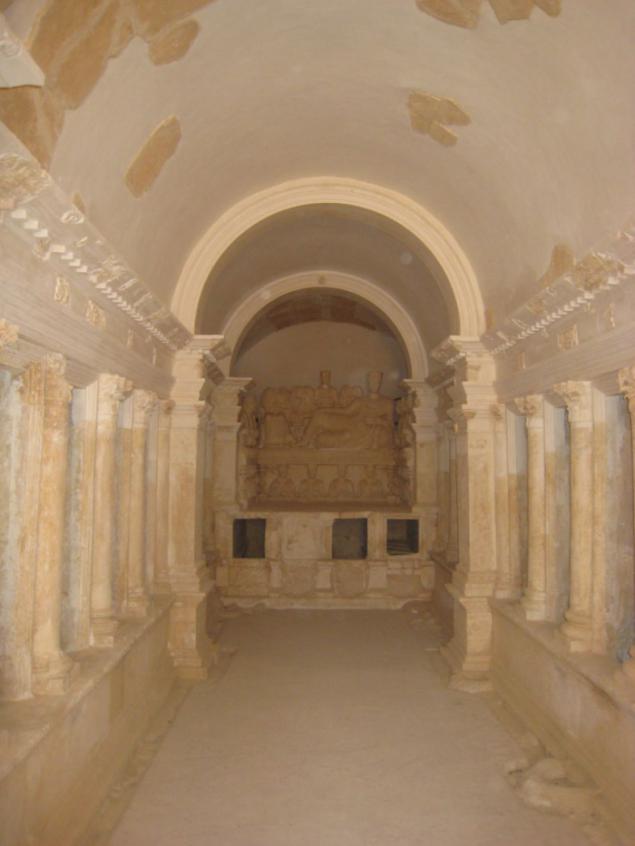
Initially, Palmyra was founded as a settlement in the oasis in the northern Syrian desert called Tadmor. Despite the fact that the Roman province of Syria was established in 64 BC, the population of Tadmor (mainly Arabs and Arameans) remained semi-independent for half a century. They controlled the trade routes between the Mediterranean coast of Syria, and the lands of the Parthians to the east of the Euphrates. Palmyra was located just on two strategic trade routes: from the Far East and India to the Persian Gulf, as well as on the Silk Road.

When the Roman emperor Tiberius (14-37 AD.) Tadmor was incorporated into the province of Syria, and renamed to Palmyra, the "city of palm trees." After capture by the Romans in 106 the Nabataean kingdom of Palmyra was the most important political and commercial center in the Middle East, taking over the palm of Petra.
In 129, the emperor Hadrian Palmyra granted the status of "free city", giving residents the right of free settlement and significant trading privileges. In 217, the emperor Caracalla gave the right Palmyra colony and its governor appointed senator Septimius Odenata. Soon Odenat he and his son were killed in a rebel conspiracy. Ruler of Palmyra in 267, she became the wife of the second son Odenata - Zenobia, in which the city reached its greatest prosperity. Zenobia was a very ambitious woman, and even stated that she is descended from Cleopatra.
In 272, the Emperor Aurelian took Palmyra and Zenobia brought to Rome as his trophy. In 273 Palmyra was razed to the ground, and all the inhabitants were slaughtered as a result of an act of retribution for the revolt of the local population, during which the city had killed about 600 Roman archers.
In VI. Emperor Justinian was trying to rebuild the city and rebuilt the fortifications.
In 634, the city was conquered by the Arabs.
Strong earthquake in 1089 nearly erased from the face of the earth Palmyra.
In 1678, Palmyra found two English merchant who lived in the city of Aleppo in Syria.
Since 1924 in Palmyra actively conducting archaeological excavations carried out by scientists from Britain, France, Germany, Switzerland, and from May 1959 and Poland.
In 1980, UNESCO included the organization of Palmyra in the list of objects that have a status of "World Heritage».
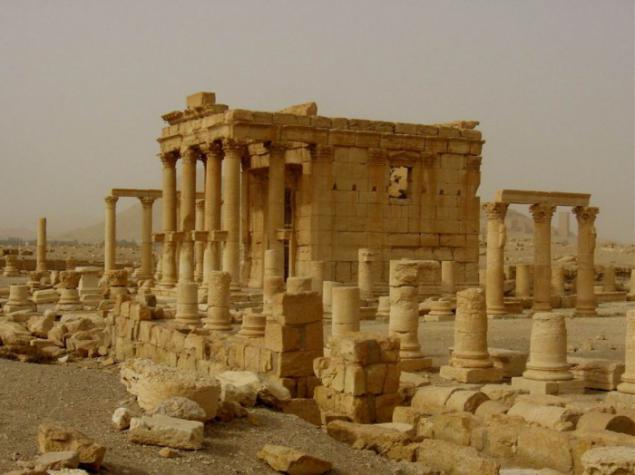
History of Palmyra - a fabulous city in the desert, and a kind of "window from Europe to Asia" - through poetic metaphor was associated with another city on earth - St. Petersburg. In 1755 the St. Petersburg magazine "Monthly Compositions for Use and Entertainment employees" was published a brief retelling of the book of Palmyra, published in 1753 in London by British travelers G. Dawkins and Robert Wood. The text of this publication in Russian, especially the remark about the art of Palmyra flourished at a time when "the arts of Greece and Rome had built were high excellence level" associated with the "Greek project" Grand Duchess Catherine Alexeevna, the future Empress Catherine II . Thus arose the image of the "Northern Palmyra».
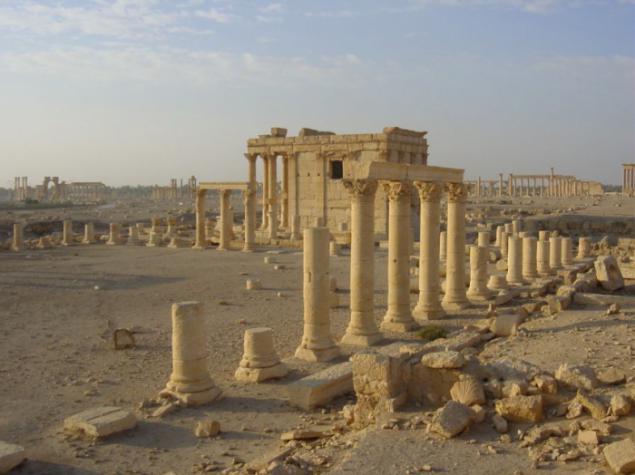
His grandchildren, Catherine II named Alexander (in honor of Alexander the Great, who opened the way to Asia) and Constantine (in memory of the Byzantine emperor), which meets the plans to create a great empire in the Balkans. Palmyra in the minds of educated people Catherine's time was associated with the idea of "expanding window" created by Tsar Peter, not only in Europe but also in Asia, and myself Catherine is compared with the capricious Queen Zenobia, widow of the king Odenata that after the death of her husband intends to create a huge kingdom between East and West.

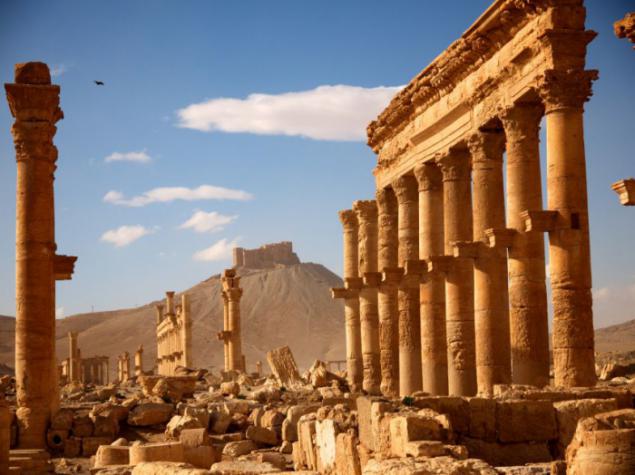
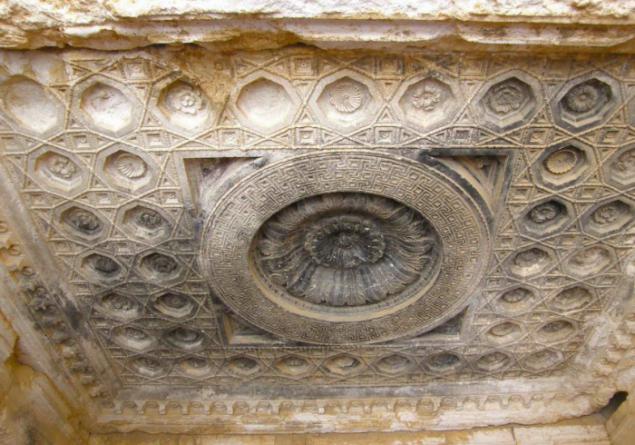
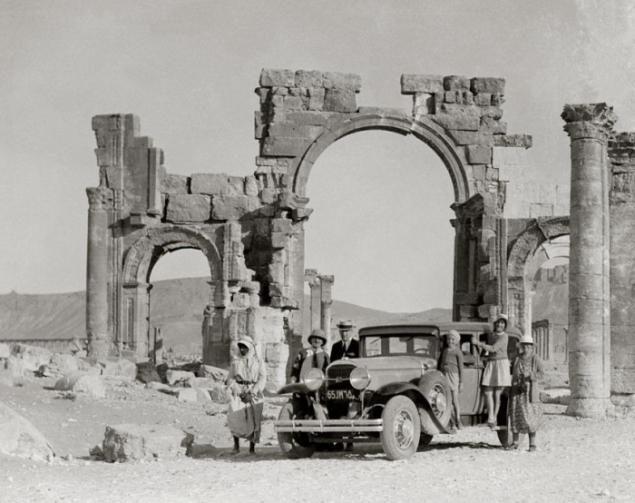
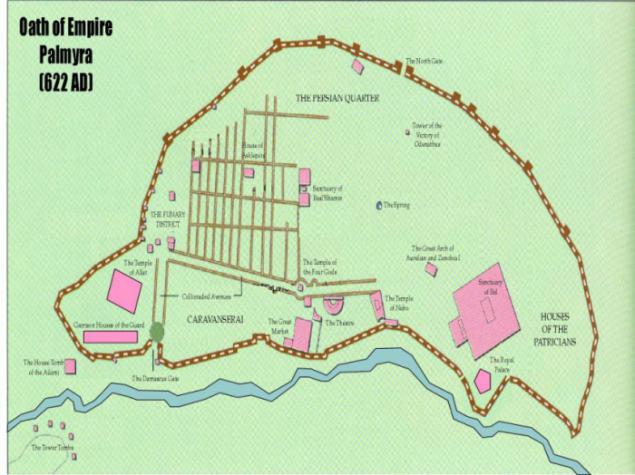
©
Palmyra - one of the richest cities of late antiquity, situated in one of the oases of the Syrian desert between Damascus and the Euphrates, 240 km north-east of the first, and 140 km from the second.

On the golden, sun-warmed walls carved leaves and bunches of grapes, camels, eagles. Before our time has remained unreconstructed Palmyra, later layers it does not obscure.
In the history, there are many amazing paradox: Pompeii, for example, has kept us volcanic lava and Palmyra - human forgetfulness. She was thrown and forgotten people.
And once it started with Efki - underground source with lukewarm water, donating sulfur. Desperate travelers, pilgrims, merchants staged a halt here, watered tired camels, horses and donkeys, smashed the tents for the night. Over time, there grew up a kind of transshipment point - the intersection brisk sale. Then he turned to the city's customs, inns and taverns. City changers, traders, hawkers, Konovalov, vagabonds, soldiers, priests, many different religions, doctors, runaway slaves, masters of all trades.


And once it started with Efki - underground source with lukewarm water, donating sulfur. Desperate travelers, pilgrims, merchants staged a halt here, watered tired camels, horses and donkeys, smashed the tents for the night. Over time, there grew up a kind of transshipment point - the intersection brisk sale. Then he turned to the city's customs, inns and taverns. City changers, traders, hawkers, Konovalov, vagabonds, soldiers, priests, many different religions, doctors, runaway slaves, masters of all trades.
It sold male and female slaves from Egypt and Asia Minor. Highly prized wool, dyed purple; merchants, touting their wares, argued that compared with other Palmyra purple fabric faded look, as if they cast dust. From Arabia and India brought spices and aromatic substances. Always has been the demand for wine, salt, clothes, harness and footwear.

Under the arches of the Arc de Triomphe were traded stood multilingual hum, but it was called Arc Europeans. In their submissions arches and gates are set to praise the high-profile military victories and in honor of the great generals. But Palmyra architects to solve other problems: double gates arches were set at an angle and how to conceal fracture streets, straightened her.
To have survived the second important crossroads of the city - tetrapylon. It was built from granite monoliths on four huge pedestals. Here, too, was in full swing trade, stone floors shops have survived to the present time.
The city had many temples built their fun on the conscience.

Palmyra were multilingual people, wanderers of the desert, they did not want to obey God only. In their religious rituals they are often remembered Bel - god of the sky, it is dedicated to one of the most interesting churches in the Middle East (the prototype of Baalbek). Temple stood out among all the buildings in the city, had a central hall area of 200 square meters. It was then, and spread throughout the ancient East the fame of the beauty and perfection of Palmyra.

In the temple were three entrances decorated with gilded panels. Today they are replaced plank gate through which tourists get to the sanctuary. Broken plate crowned dragon's teeth, giving sanctuary menacing look. It preserves the special entry that was made for the slaughter of camels, bulls and goats, as well as drain the blood - the god Bel demanded victims.
In Palmyra temple was built in honor of the god Nabq - son of Marduk, the Babylonian ruler of heaven. TOY was in charge of the fate of death, and was a messenger from the gods mingled Palmyra pantheon. A native of Mesopotamia, he got on with Baalshaminom Phoenician, Arab and Allat Olympian Zeus.

From the temple of Nabq was alone the foundation of the temple Allat - only the door, but the temple Baalshamina (Phoenician god of thunder and fertility) stands to this day.
And earthly affairs were in charge of Palmyra leaders, priests, rich merchants, who sat in the Senate. Their decisions are approved by the governor appointed by Rome. The Emperor Hadrian visited Palmyra, gave the city a certain independence - recalled the governor, cut taxes, the government gave local chiefs.
There were years, flew decade, Palmyra and gradually became one of the most prosperous cities in the Middle East. Just as in Rome, where gladiatorial contests were held, young men fought with wild beasts. Frantihi of the upper classes to dress according to the Roman fashion, and even ahead of it.

Children were given Roman names, often in conjunction with Palmyra.
Ancient palmirtsy loved erect monuments to each other. Almost all of the Big column colonnade, temples and public buildings are in the middle of the stone ledge on which stood statues of notable and respected people. At one time, the column of agar (Palmyra forum, surrounded by porticos and laden with busts) were kept about 200 of such images.
But gradually stopped listening to the leaders of Palmyra Senate began its policy. The ruler of Palmyra Odenat defeated the troops of the Persian king, but he was well aware that any attempt to elevate his cause in Rome, fear and anger. But regardless of his will and Palmyra, and he gained more and more influence in the Middle East.

Then resorted Rome (as it is very often the case) to a simple means - the physical elimination of man. Roman authorities Suri in year 267 (or 266) Odenata invited to discuss current affairs in Emessu (modern city of Homs). And there, during a meeting he and the eldest son of Herodians fell into the hand of his nephew Meon.
According to other historical records, the murder of Odenata involved his wife, Zenobia, who was stepmother Herodians. She allegedly wanted to eliminate both of them to make way for the authorities to his young son Vaballatu. In fact, the energetic widow of the rules themselves. With its name is associated with great fame of Palmyra, expanding the boundaries of the state. She endured the hardships of military campaigns as well as any of his soldiers.

In the local language the name of Zenobia sounded like Bat Zobbi. Translated into Russian, it means - the daughter of a merchant, the merchant. She was a very beautiful woman, it can be seen even on the coins, which have preserved its image. "Matt, dark skin and black eyes of striking beauty, look alive with the divine splendor. She dressed in luxurious costumes, the military was able to wear armor and weapons ».
According to ancient chroniclers, Zenobia was an educated woman, esteemed scientists, sympathetic consideration to the philosophers and sages.
The Roman emperor Gallienus had hoped that the second son Odenata under age will not be able to manage Palmyra. However, he did not realize that the widow, the beautiful Zenobia, the cleverest and the education of women, was ready to engage in public activities. Her teacher, the famous Syrian philosopher Cassius Longinus from Emessy, advised her to enthrone Vaballata with him and become regent. She cautiously waited an hour expulsion of the Roman legions from the Middle East to adopt forever in the kingdom, which it will, the power of his dynasty.

For the time Zenobia carefully hid their intentions, hoping that will help her son to inherit his father's throne. But Rome was afraid enhance margins and retained only the title of the ruler of Palmyra vassal potentates. And then Zenobia declared war on powerful Rome.
The Romans believed that the troops Palmyra refuse to go into battle under the command of a woman. And much miscalculated. Palmyra chiefs Zabbey Zabda and swore allegiance to Zenobia. Jumping to her side the army soon took possession of Syria, Palestine, Egypt, and the north reached the Bosporus and Dardanelles straits.

Military victory Zenobia alarmed Rome. Roman Emperor Lucius Domitius Aurelian decided to oppose her army. After the defeat at Homs Zenobia in Palmyra had hoped to sit, but to sustain a long siege failed. It only remained to take all the wealth of the city and retreat to the Euphrates - and then save the width of the river and accuracy of archers famed Palmyra. But the cavalry Aurelian followed on the heels, and the river itself Zenobia captured. Palmyra fell.
It was seventeen centuries ago. The further fate of Zenobia mysterious and generates a lot of conjecture: if headstrong queen was murdered, though her in golden chains held in Rome, though married to a Roman senator, and she lived to old age.
Taking Palmyra, Roman armies brought down the statue of Zenobia, but the town was not touched. When the Emperor Diocletian is even resumed construction: Zenobia residence was converted into a Roman military camp, the barracks are expanded, improved water, erected Christian basilica.

Several times palmirtsy uprisings for independence, but failed.
Gradually he left the city to know the city, deprived of connections with the East went merchants, followed by the idle drivers were caravans, officials and skilled craftsmen. And Palmyra beginning to wither, become commonplace in the border post, a place of reference.

The Arabs have taken it without a fight, the citizens could not even put up resistance. Yes, they have not lived in the city, and huddled behind the walls of the sanctuary of Bela, nalepili there are many dark and cramped mud shacks. After 2-3 generations no one and did not remember the names of the gods, nor the names of temples or public buildings destination.
Then for many years to come the Turks who do not have a clue about the culture of the peoples subject to them, and others are not allowed to study it. Excavations have been banned throughout the Ottoman Empire. Nobody cared about the past, to the glorious history of the city is now dying. Oblivion Dust hid Palmyra from the living memory of mankind. Palmyra had to be rediscovered.

The honor of opening Palmyra history attributes the Italian Pietro della Valle. For a long time, with great difficulty getting to Palmyra travelers in the XVII century, but when they returned to Europe, they just do not believe it. City in the Syrian desert? Would this be? But after 100 years, the artist brought to England Wood drawings made in Palmyra. With the publication of these engravings and started the fashion for Palmyra, were detailed descriptions of the ancient city, travel essays.

The most interesting finding of the time made our compatriot, Petersburger SS Abamelek Lazare. He discovered and published the Greek-Aramaic inscription detailing the customs rules (so-called "Palmyra tariff"). Today this document is stored in the Hermitage. In ancient times, the locals called (it is now called) Palmyra "Tadmor." Translated it means "to be a wonderful, beautiful».

In the XX century it seriously interested. Gradually but steadily growing interest in Russian to Palmyra. Russian Archaeological Institute in Constantinople, sent an expedition, the researchers did a lot of photos, drawings, diagrams, plans, topographic maps of the city. On the basis of these materials Professor F. Assumption issued after a thorough work.

Towering in the desert colonnades legendary Palmyra still beckon travelers who are surprised to discover two neighboring Palmyra - Tadmor two. One of them - the old, the other - the new, young. In one of them it is no longer people live, it has become a perpetual museum, the other from 1928 began to settle Bedouins, poor people. In 2003, the Syrian government passed a law on the construction of a new Palmyra. The city has become improving, new streets were built, electricity. Hardworking inhabitants are laid palm groves, orchards, vegetable gardens, plowed fields, bred cattle. Traditionally palmirtsy engaged in trade, weave carpets, shawls, sew national clothes and sell all tourists. New Palmyra does not compete with the old, because she is its continuation.

Initially, Palmyra was founded as a settlement in the oasis in the northern Syrian desert called Tadmor. Despite the fact that the Roman province of Syria was established in 64 BC, the population of Tadmor (mainly Arabs and Arameans) remained semi-independent for half a century. They controlled the trade routes between the Mediterranean coast of Syria, and the lands of the Parthians to the east of the Euphrates. Palmyra was located just on two strategic trade routes: from the Far East and India to the Persian Gulf, as well as on the Silk Road.

When the Roman emperor Tiberius (14-37 AD.) Tadmor was incorporated into the province of Syria, and renamed to Palmyra, the "city of palm trees." After capture by the Romans in 106 the Nabataean kingdom of Palmyra was the most important political and commercial center in the Middle East, taking over the palm of Petra.
In 129, the emperor Hadrian Palmyra granted the status of "free city", giving residents the right of free settlement and significant trading privileges. In 217, the emperor Caracalla gave the right Palmyra colony and its governor appointed senator Septimius Odenata. Soon Odenat he and his son were killed in a rebel conspiracy. Ruler of Palmyra in 267, she became the wife of the second son Odenata - Zenobia, in which the city reached its greatest prosperity. Zenobia was a very ambitious woman, and even stated that she is descended from Cleopatra.
In 272, the Emperor Aurelian took Palmyra and Zenobia brought to Rome as his trophy. In 273 Palmyra was razed to the ground, and all the inhabitants were slaughtered as a result of an act of retribution for the revolt of the local population, during which the city had killed about 600 Roman archers.
In VI. Emperor Justinian was trying to rebuild the city and rebuilt the fortifications.
In 634, the city was conquered by the Arabs.
Strong earthquake in 1089 nearly erased from the face of the earth Palmyra.
In 1678, Palmyra found two English merchant who lived in the city of Aleppo in Syria.
Since 1924 in Palmyra actively conducting archaeological excavations carried out by scientists from Britain, France, Germany, Switzerland, and from May 1959 and Poland.
In 1980, UNESCO included the organization of Palmyra in the list of objects that have a status of "World Heritage».

History of Palmyra - a fabulous city in the desert, and a kind of "window from Europe to Asia" - through poetic metaphor was associated with another city on earth - St. Petersburg. In 1755 the St. Petersburg magazine "Monthly Compositions for Use and Entertainment employees" was published a brief retelling of the book of Palmyra, published in 1753 in London by British travelers G. Dawkins and Robert Wood. The text of this publication in Russian, especially the remark about the art of Palmyra flourished at a time when "the arts of Greece and Rome had built were high excellence level" associated with the "Greek project" Grand Duchess Catherine Alexeevna, the future Empress Catherine II . Thus arose the image of the "Northern Palmyra».

His grandchildren, Catherine II named Alexander (in honor of Alexander the Great, who opened the way to Asia) and Constantine (in memory of the Byzantine emperor), which meets the plans to create a great empire in the Balkans. Palmyra in the minds of educated people Catherine's time was associated with the idea of "expanding window" created by Tsar Peter, not only in Europe but also in Asia, and myself Catherine is compared with the capricious Queen Zenobia, widow of the king Odenata that after the death of her husband intends to create a huge kingdom between East and West.





©


